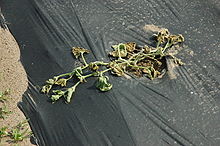This article needs additional citations for verification. (May 2020) |
| Bacterial wilt | |
|---|---|

| |
| Scientific classification | |
| Domain: | Bacteria |
| Phylum: | Pseudomonadota |
| Class: | Gammaproteobacteria |
| Order: | Enterobacterales |
| Family: | Erwiniaceae |
| Genus: | Erwinia |
| Species: | E. tracheiphila
|
| Binomial name | |
| Erwinia tracheiphila (Smith 1895) Bergey et al. 1923
| |
Bacterial wilt is a complex of diseases that occur in plants such as Cucurbitaceae and Solanaceae (tomato, common bean,[1][2] etc.) and are caused by the pathogens Erwinia tracheiphila, a gram-negative bacterium, or Curtobacterium flaccumfaciens pv. flaccumfaciens, a gram-positive bacterium. Cucumber and melon plants are most susceptible, but squash, pumpkins, and gourds may also become infected.
Bacterial wilts of tomato, Capsicum (pepper), Solanum ovigerum (eggplant), and Irish potato can be caused by (Burkholderiaceae) Ralstonia solanacearum.[3] Other bacteria in the family Burkholderiaceae can cause bacterial wilt of carnation.
Bacteria in the genus Xanthomonas can cause banana bacterial wilt or bacterial wilt in the genus Agrostis.[4]
- ^ Martins, Samuel Julio; Medeiros, Flavio Henrique Vasconcelos; Souza, Ricardo Magela; Vilela, Laize Aparecida Ferreira (2014). "Is curtobacterium wilt biocontrol temperature dependent?". Acta Scientiarum. Agronomy. 36 (4): 409. doi:10.4025/actasciagron.v36i4.18018.
- ^ Martins, Samuel Julio; De Medeiros, Flavio Henrique Vasconcelos; De Souza, Ricardo Magela; De Resende, Mário Lúcio Vilela; Ribeiro, Pedro Martins (2013). "Biological control of bacterial wilt of common bean by plant growth-promoting rhizobacteria". Biological Control. 66: 65–71. doi:10.1016/j.biocontrol.2013.03.009.
- ^ Allen, Caitilyn; Prior, Philippe; Hayward, Alan Christopher, eds. (2005). Bacterial Wilt: The Disease and the Ralston solanacearum Species Complex. St. Paul: APS Press. ISBN 0-89054-329-1; 508 pages. (APS Press bestseller for 2005)
{{cite book}}: CS1 maint: postscript (link) - ^ Sarkar, Shamayeeta; Chaudhuri, Sujata (2016). "Bacterial wilt and its management". Current Science. 110 (8): 1439–1445. JSTOR 24908099.